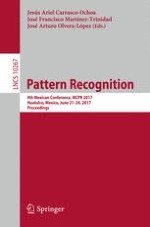2017 | Buch
Pattern Recognition
9th Mexican Conference, MCPR 2017, Huatulco, Mexico, June 21-24, 2017, Proceedings
herausgegeben von: Jesús Ariel Carrasco-Ochoa, José Francisco Martínez-Trinidad, José Arturo Olvera-López
Verlag: Springer International Publishing
Buchreihe : Lecture Notes in Computer Science
